As an Amazon Associate I earn from qualifying purchases.
Rice vinegar, a staple in many Asian cuisines, is a versatile ingredient that can elevate the flavors of your dishes, from sushi rice to stir-fries and beyond. Beyond its culinary uses, rice vinegar has surprising applications in cleaning and household tasks. In this comprehensive guide, we’ll explore the various ways to use rice vinegar in your kitchen, highlighting its unique qualities and providing expert tips for handling and storing it safely. Whether you’re an experienced chef or a kitchen novice, you’ll discover how this tangy elixir can transform your culinary creations and simplify your household chores. So, let’s embark on a journey to unlock the potential of rice vinegar and enhance your culinary and domestic prowess.
Introduction to Rice Vinegar
Rice vinegar is a fundamental and versatile ingredient in many Asian and international cuisines. It is a type of vinegar made from fermented rice and is known for its mild acidity and subtly sweet flavor. Rice vinegar plays a crucial role in enhancing the taste of various dishes, from sushi to salad dressings and beyond. In this introduction to rice vinegar, we’ll explore its origins, types, and the culinary uses that make it a staple in kitchens around the world.
Origins and Production
- Rice vinegar has a rich history that dates back thousands of years, originating in East Asia, particularly in China, Japan, and Korea. It is made through a fermentation process that begins with glutinous or regular rice. The rice is first fermented into alcohol, then further fermented into vinegar by acetic acid bacteria. The result is a clear, mild vinegar with a distinct rice aroma.
Types of Rice Vinegar
- There are several varieties of rice vinegar available, each with its unique characteristics:
- White Rice Vinegar: This is the most commonly used type of rice vinegar. It has a clean, mild flavor and is a popular choice for making sushi rice and salad dressings.
- Seasoned Rice Vinegar: Seasoned rice vinegar is pre-seasoned with sugar and salt, making it a convenient option for sushi rice and marinades. It has a slightly sweet taste and is often used in Japanese cooking.
- Red Rice Vinegar: This variety has a deeper color and a more robust flavor than white rice vinegar. It is commonly used in Chinese and Korean cuisines for pickling and in dipping sauces.
- Black Rice Vinegar: Popular in Chinese cuisine, black rice vinegar has a rich, malty flavor and is often used in braised dishes and soups.
Culinary Uses
- Rice vinegar’s mild acidity and subtle sweetness make it a versatile ingredient in the culinary world. Some of its common uses include:
- Sushi Rice: Rice vinegar is a key component in making sushi rice, where it adds a delightful tanginess and helps to season and bind the rice grains.
- Salad Dressings: It is used to create light and tangy salad dressings, providing a refreshing contrast to fresh greens and vegetables.
- Marinades and Pickling: Rice vinegar can be used in marinades for meats, poultry, and seafood, as well as in pickling solutions for vegetables and fruits.
- Stir-Fries and Sauces: Adding rice vinegar to stir-fry dishes and sauces can provide a bright and balanced flavor profile.
- Soups and Broths: It helps balance the flavors in various soups and broths, particularly in dishes like hot and sour soup.
- Dipping Sauces: Rice vinegar is a base for many dipping sauces, complementing dumplings, spring rolls, and appetizers.
- Ceviche and Poke Bowls: In these dishes, rice vinegar “cooks” seafood, contributing to the unique flavors and textures.
- Desserts: Surprisingly, rice vinegar can also be used in desserts, especially in fruit salads and preserves.
Rice vinegar’s culinary applications extend beyond Asian cuisine, making it a versatile and valuable addition to any kitchen. Its subtle yet distinct flavor can elevate a wide range of dishes, from savory to sweet. As you explore the world of cooking, rice vinegar is a valuable ally, ready to add depth and balance to your culinary creations.
How to Use Rice Vinegar
1. How to Use Rice Vinegar to Make Sushi Rice
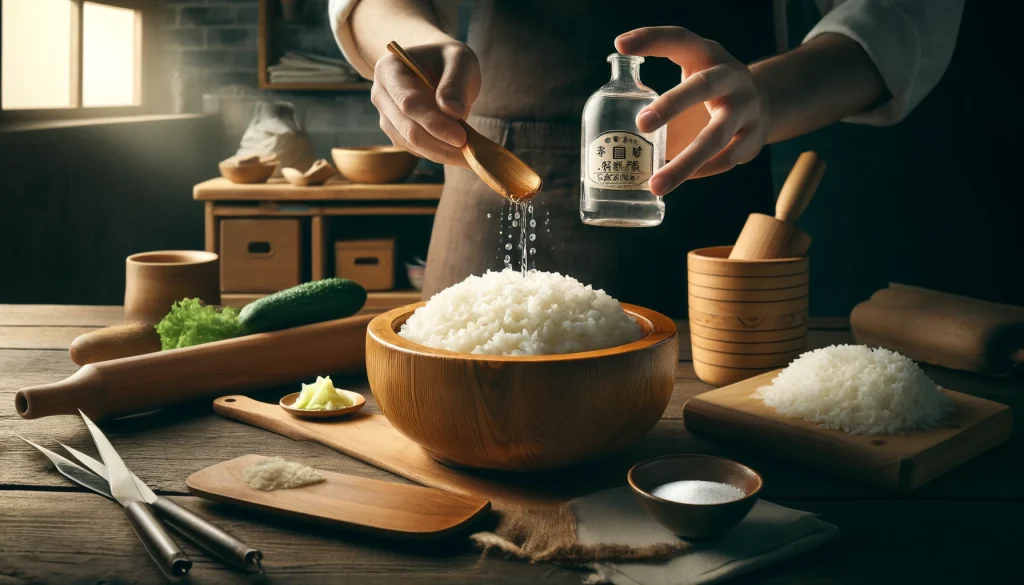
Making sushi rice is a fundamental step in preparing delicious sushi. Rice vinegar is a key ingredient that adds flavor and stickiness to the rice. Here’s a step-by-step guide on how to use rice vinegar to make sushi rice:
Ingredients:
- 2 cups of sushi rice (short-grain Japanese rice)
- 1/2 cup of rice vinegar
- 2 tablespoons of sugar
- 1 teaspoon of salt
- A large wooden or plastic mixing bowl
- A wooden rice paddle or spatula
Instructions:
Step 1: Rinse the Rice
- Place the sushi rice in a fine-mesh strainer or sieve and rinse it under cold running water until the water runs clear. This helps remove excess starch from the rice and prevents it from becoming overly sticky.
Step 2: Cook the Rice
- 2. Cook the rinsed rice according to the package instructions. You can use a rice cooker or stovetop method. Follow the recommended water-to-rice ratio on the rice package.
Step 3: Prepare the Vinegar Mixture
- 3. While the rice is cooking, combine the rice vinegar, sugar, and salt in a small saucepan. Heat the mixture over low heat, stirring continuously until the sugar and salt completely dissolve. Do not let it boil.
Step 4: Cool the Vinegar Mixture
- 4. Once the sugar and salt have dissolved, remove the vinegar mixture from the heat and let it cool to room temperature. You can speed up the cooling process by transferring it to a bowl and placing it in the refrigerator.
Step 5: Transfer the Cooked Rice
- 5. When the rice is done cooking, transfer it to a large, non-metallic bowl or a traditional wooden sushi rice tub while it’s still hot. The wooden container is preferred as it helps absorb excess moisture.
Step 6: Season the Rice
- 6. Gently spread the hot rice out in the bowl or sushi tub to maximize surface area. Sprinkle the cooled vinegar mixture evenly over the rice.
Step 7: Mix and Fan
- 7. Use a wooden rice paddle or spatula to mix the vinegar mixture into the rice gently. Make slicing and folding motions to avoid smashing the rice grains. As you mix, fan the rice using a hand fan or a piece of cardboard to help cool it down. Continue mixing and fanning until the rice has cooled to room temperature.
Step 8: Cover and Rest
- 8. Once the sushi rice has cooled and is well-seasoned, cover it with a clean, damp cloth or plastic wrap to prevent it from drying out. You can also place a lid on the wooden sushi rice tub if you used one.
Your sushi rice is now ready to be used in various sushi recipes, such as sushi rolls (maki), nigiri sushi, and sashimi bowls. The seasoned rice vinegar will give your sushi rice the traditional tangy and slightly sweet flavor that makes sushi so delightful.
2. Using Rice Vinegar to Create Light and Tangy Salad Dressings
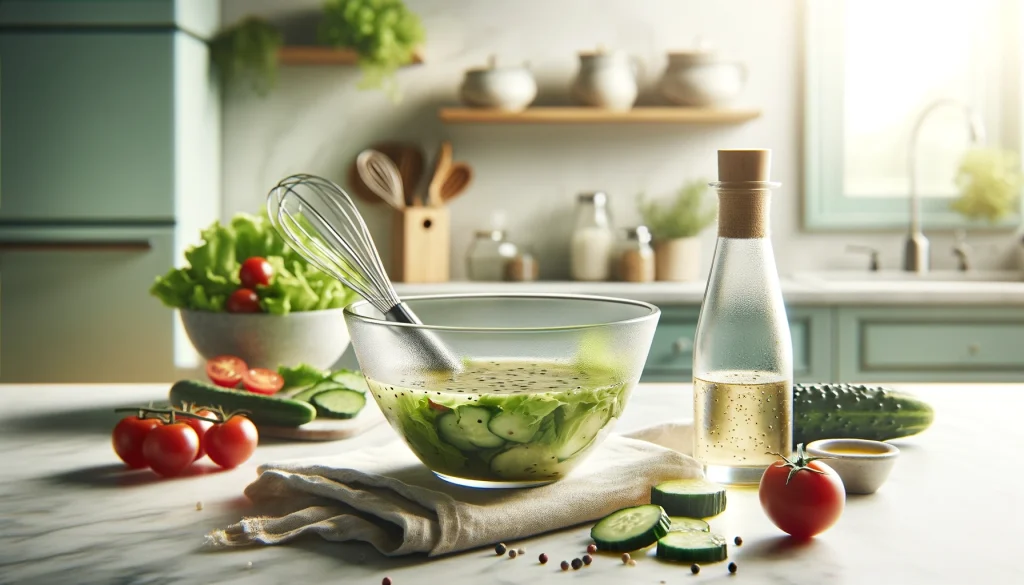
Rice vinegar is a fantastic ingredient for creating light and tangy salad dressings. Its mild acidity and subtle sweetness can enhance the flavors of your salads without overpowering them. Here’s a basic recipe for a rice vinegar-based salad dressing, along with some variations you can try:
Basic Rice Vinegar Salad Dressing:
Ingredients:
- 3 tablespoons rice vinegar
- 2 tablespoons vegetable oil (such as canola or grapeseed oil)
- 1 teaspoon soy sauce (optional for added umami)
- 1 teaspoon honey or sugar
- 1/4 teaspoon salt
- A pinch of black pepper
Instructions:
- In a small mixing bowl, combine the rice vinegar, vegetable oil, soy sauce (if using), honey or sugar, salt, and black pepper.
- Whisk the ingredients together until the dressing is well-emulsified. You can also use a small jar with a tight-fitting lid and shake it vigorously to combine.
- Taste the dressing and adjust the sweetness, acidity, and saltiness to your preference. You can add more honey or sugar for sweetness, more rice vinegar for tanginess, or more salt to enhance the flavor.
- Once you’re satisfied with the taste, your basic rice vinegar salad dressing is ready to use.
Variations:
Ginger Sesame Dressing:
- Add 1-2 teaspoons of grated fresh ginger and 1-2 teaspoons of toasted sesame oil to the basic dressing recipe. This adds a delightful Asian-inspired twist to your salad.
Orange Vinaigrette:
- Replace some or all of the rice vinegar with fresh orange juice for a citrusy twist. Adjust the sweetness accordingly.
Creamy Rice Vinegar Dressing:
- Add 2-3 tablespoons of mayonnaise or Greek yogurt to the basic dressing for a creamier texture and milder tang.
Garlic and Herb Dressing:
- Include minced garlic, fresh herbs (such as basil, parsley, or cilantro), and a touch of Dijon mustard for added flavor complexity.
Spicy Rice Vinegar Dressing:
- Add a pinch of red pepper flakes or a dash of hot sauce to give your dressing a spicy kick.
Honey Mustard Rice Vinegar Dressing:
- Combine rice vinegar with honey, Dijon mustard, and a touch of olive oil for a sweet and tangy dressing with a hint of mustardy zing.
Asian-Inspired Peanut Dressing:
- Mix rice vinegar with peanut butter, soy sauce, honey, and a bit of sesame oil for a creamy and nutty dressing.
Feel free to experiment with these variations or create your own by adding your favorite herbs, spices, or ingredients. Rice vinegar provides a wonderful canvas for crafting salad dressings that suit your taste preferences and complement the ingredients in your salad.
3. Incorporating Rice Vinegar into Marinades for Meats, Poultry, and Seafood

Rice vinegar can be a flavorful addition to marinades for meats, poultry, and seafood, as it adds a subtle tanginess and helps tenderize the proteins. Here’s a basic rice vinegar marinade recipe, along with some variations you can try for different types of proteins:
Basic Rice Vinegar Marinade:
Ingredients:
- 1/4 cup rice vinegar
- 2 tablespoons soy sauce (or tamari for a gluten-free option)
- 2 tablespoons vegetable oil (such as canola or grapeseed oil)
- 2 cloves garlic, minced
- 1 tablespoon honey or brown sugar
- 1 teaspoon grated ginger (optional, for extra flavor)
- Salt and black pepper to taste
Instructions:
- In a mixing bowl, combine the rice vinegar, soy sauce, vegetable oil, minced garlic, honey or brown sugar, grated ginger (if using), salt, and black pepper.
- Whisk the ingredients together until the marinade is well-blended.
- Taste the marinade and adjust the sweetness, saltiness, and tanginess to your liking. You can add more honey or rice vinegar for sweetness or tanginess, or more soy sauce for saltiness.
- Place your choice of meat, poultry, or seafood in a resealable plastic bag or a shallow dish.
- Pour the rice vinegar marinade over the protein, ensuring it’s well-coated.
- Seal the bag or cover the dish and refrigerate for at least 30 minutes, or up to 24 hours, depending on the type of protein and your desired marinating time.
- When you’re ready to cook, remove the protein from the marinade and pat it dry with paper towels before grilling, roasting, or pan-searing. You can also use the marinade as a basting sauce during cooking for extra flavor.
Variations:
Asian-Inspired Pork Marinade:
- Add a tablespoon of sesame oil and a pinch of Chinese five-spice powder to the basic marinade for a distinctive Asian flavor. Ideal for pork chops or tenderloin.
Citrus Rice Vinegar Marinade for Chicken:
- Replace some or all of the rice vinegar with citrus juice (such as orange or lemon) for a bright and zesty marinade. Great for chicken breasts or thighs.
Garlic and Herb Marinade for Seafood:
- Include fresh herbs like dill, parsley, and thyme, along with extra minced garlic, for a flavorful seafood marinade. Suitable for fish fillets or shrimp.
Teriyaki-Style Marinade for Beef:
- Combine rice vinegar with soy sauce, brown sugar, grated ginger, and minced garlic for a teriyaki-inspired beef marinade. Perfect for beef steak or kebabs.
Chili Lime Marinade for Shrimp:
- Add some lime juice, chopped cilantro, and a pinch of chili flakes for a zesty and spicy shrimp marinade.
Sesame-Ginger Marinade for Tofu:
- Create a vegetarian marinade by using rice vinegar with sesame oil, soy sauce, grated ginger, and a touch of honey for tofu or tempeh.
Remember to adjust the ingredients and quantities to suit your taste preferences and the specific protein you’re marinating. Rice vinegar can help infuse your dishes with unique and delightful flavors while also tenderizing the meat, poultry, or seafood.
4. Using Rice Vinegar in Pickling Recipes for Vegetables and Fruits

Rice vinegar can be a wonderful addition to pickling recipes for vegetables and fruits, adding a mild acidity and subtle sweetness to the pickled items. Here’s a basic guide on how to use rice vinegar in pickling, along with a simple pickling recipe:
Basic Rice Vinegar Pickling Recipe:
Ingredients:
- 2 cups of vegetables or fruits (e.g., cucumbers, carrots, radishes, onions, cauliflower, or strawberries)
- 1 cup of rice vinegar
- 1 cup of water
- 2 tablespoons of sugar
- 1 tablespoon of salt
- Optional flavorings: garlic cloves, peppercorns, dill, mustard seeds, chili flakes, or herbs
Instructions:
- Prepare the vegetables or fruits by washing and cutting them into your desired shapes. For cucumbers, you can slice them into rounds or make spears.
- In a saucepan, combine the rice vinegar, water, sugar, and salt. If you want to add any optional flavorings, such as garlic cloves, peppercorns, or herbs, add them to the mixture.
- Heat the mixture over medium heat, stirring occasionally, until the sugar and salt completely dissolve. This will create the pickling brine.
- While the brine is heating, pack your prepared vegetables or fruits into clean, sterilized glass jars. Make sure to leave some headspace at the top of the jars.
- Once the sugar and salt have dissolved, remove the brine from heat and let it cool to room temperature.
- Pour the cooled brine over the vegetables or fruits in the jars, ensuring they are fully submerged. Use a clean, non-metallic utensil to release any trapped air bubbles.
- Seal the jars with airtight lids.
- Let the pickled vegetables or fruits sit at room temperature for about an hour. Then, refrigerate them for at least 24 hours to develop the flavors. They will continue to improve over time, so you can enjoy them for several weeks.
Variations:
- Sweet and Sour Pickles: Add extra sugar to the brine for sweeter pickles.
- Spicy Pickles: Include chili flakes, sliced jalapeños, or other hot peppers to the brine for a spicy kick.
- Asian-Inspired Pickles: Enhance the brine with grated ginger, garlic, and a touch of soy sauce for an Asian twist.
- Herb-Infused Pickles: Experiment with herbs like dill, thyme, or rosemary for an aromatic touch.
- Colorful Vegetable Medley: Mix and match various vegetables for a colorful and diverse pickle medley.
- Fruit Pickles: Try pickling fruits like strawberries, grapes, or watermelon for a sweet and tangy treat.
Remember that the pickling time can vary depending on the thickness of the vegetables or fruits and your personal preference. Taste the pickles after 24 hours and adjust the seasoning or flavors as needed. Rice vinegar’s gentle acidity and subtle sweetness make it a versatile choice for pickling, allowing you to create unique and delicious preserved treats.
5. How to Add Rice Vinegar to Stir-Fry Dishes For a Burst of Flavor

Rice vinegar can add a burst of flavor to stir-fry dishes, providing a tangy and slightly sweet element that balances the savory and umami flavors. Here’s how to use rice vinegar effectively in your stir-fry:
Ingredients:
- 1-2 tablespoons rice vinegar (adjust to taste)
- Your choice of protein (e.g., chicken, beef, shrimp, tofu)
- Vegetables (e.g., bell peppers, broccoli, carrots, snap peas)
- Garlic and ginger (minced or grated)
- Soy sauce or tamari (for seasoning)
- Cooking oil (such as vegetable or sesame oil)
- Optional stir-fry sauce or seasonings (hoisin, oyster sauce, or sriracha for heat)
- Optional toppings (sesame seeds, green onions, or chopped cilantro)
Instructions:
1. Prepare Your Ingredients:
- Slice or dice your protein and vegetables into bite-sized pieces.
- Mince or grate fresh garlic and ginger.
- If you’re using a stir-fry sauce, have it ready.
2. Heat Your Wok or Skillet:
- Heat a wok or large skillet over high heat until it’s smoking hot.
3. Add Cooking Oil:
- Add a tablespoon of cooking oil to the hot wok or skillet and swirl it around to coat the surface.
4. Sear the Protein:
- Add the protein to the hot oil and sear it until it’s browned and cooked through. Depending on the protein, this may take a few minutes.
5. Stir-Fry the Vegetables:
- Add the minced garlic and ginger to the wok or skillet and stir-fry for about 30 seconds until fragrant.
- Add your choice of vegetables and stir-fry them for a few minutes until they become tender-crisp. You can add them all at once or in stages, starting with the hardest vegetables and finishing with the quickest-cooking ones.
6. Season with Soy Sauce:
- Drizzle soy sauce or tamari over the protein and vegetables for seasoning. Start with a tablespoon and adjust to your taste. This adds saltiness and depth of flavor.
7. Add Rice Vinegar:
- Drizzle 1-2 tablespoons of rice vinegar over the stir-fry. The amount can vary depending on your taste preferences and the quantity of food you’re cooking.
8. Optional Stir-Fry Sauce:
- If you’re using a stir-fry sauce (such as hoisin or oyster sauce), add it at this point. Use 2-3 tablespoons or adjust to taste. Stir well to combine.
9. Toss and Combine:
- Toss and stir-fry everything together for another minute or two, ensuring the rice vinegar and any sauces are evenly distributed.
10. Taste and Adjust:
- Taste the stir-fry and adjust the seasonings, adding more rice vinegar, soy sauce, or other sauces as needed to achieve your desired flavor balance.
11. Finish and Serve:
- Remove the stir-fry from heat as soon as the vegetables are tender but still crisp. Overcooking can lead to limp vegetables.
- Optional: Garnish your stir-fry with sesame seeds, chopped green onions, or fresh cilantro for added flavor and visual appeal.
Serve your flavorful rice vinegar-enhanced stir-fry over rice or noodles, and enjoy the delicious balance of sweet, tangy, and savory flavors. Rice vinegar’s brightness can elevate the overall taste of your dish and make it more vibrant and appealing.
6. Enhancing the Taste of Noodle Dishes like Cold Sesame Noodles or Pad Thai with Rice Vinegar
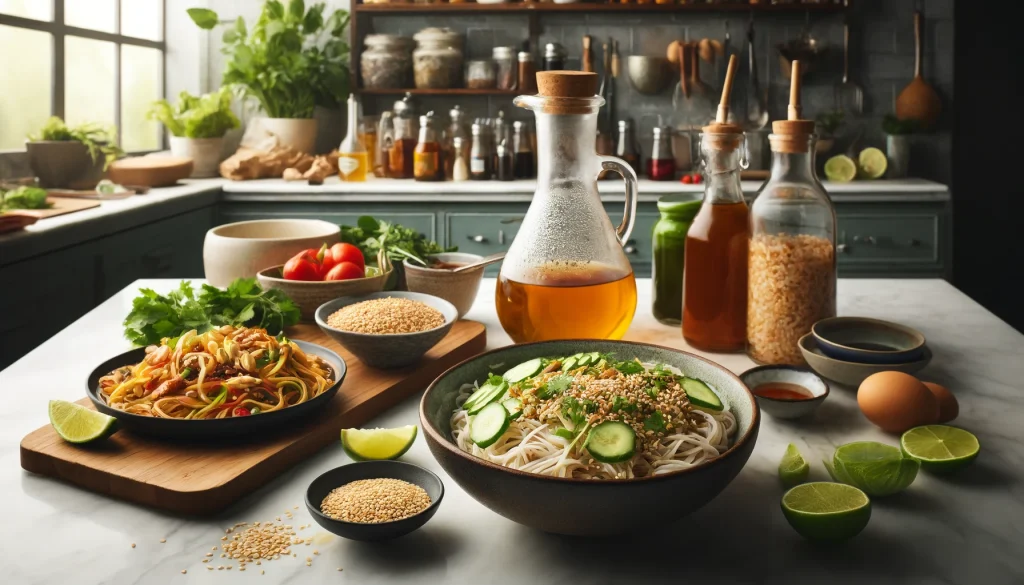
Rice vinegar can be a delightful addition to noodle dishes like cold sesame noodles or pad Thai, enhancing their flavor with a touch of acidity and sweetness. Here’s how to use rice vinegar to elevate the taste of these dishes:
a). Cold Sesame Noodles:
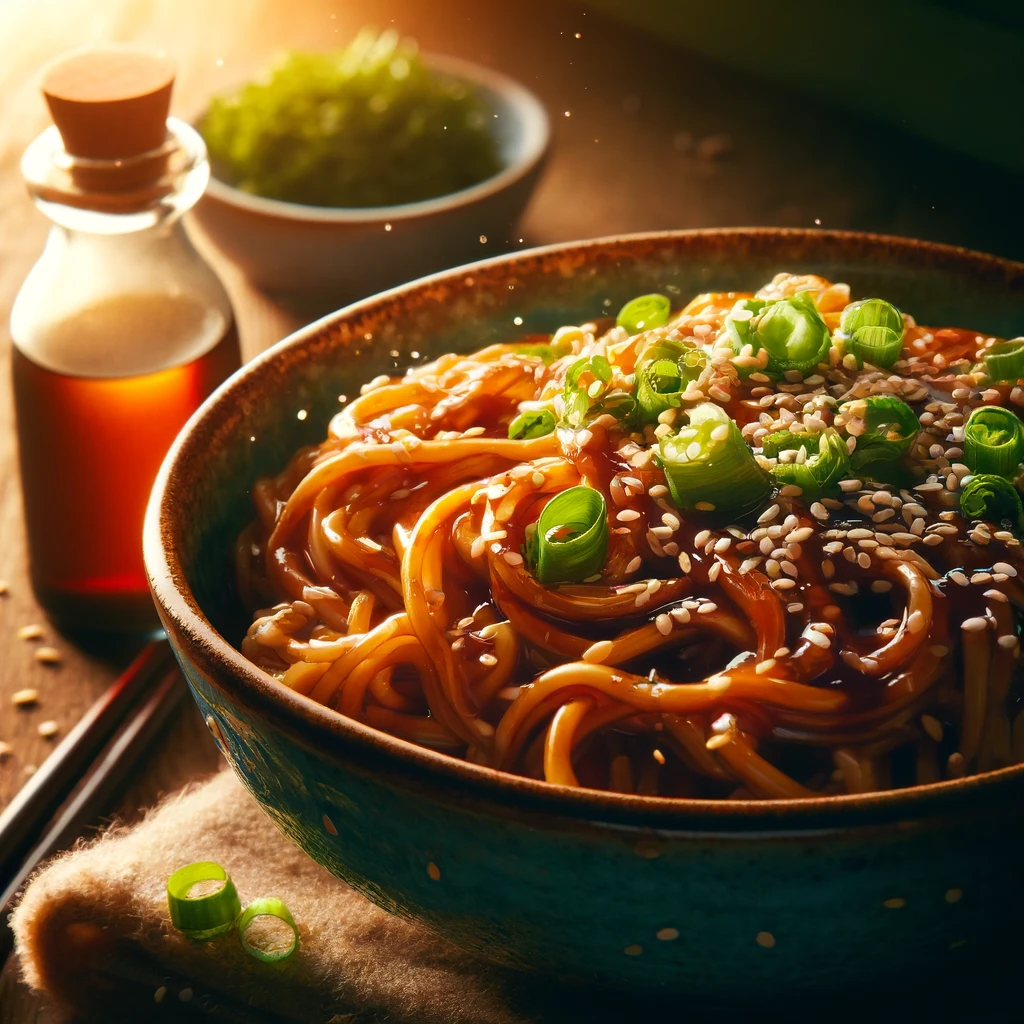
Ingredients:
- Cooked and chilled Chinese egg noodles or soba noodles
- 2 tablespoons rice vinegar
- 2 tablespoons soy sauce or tamari
- 1 tablespoon sesame oil
- 1 tablespoon peanut butter
- 1 tablespoon honey or brown sugar
- 2 cloves garlic, minced
- 1-2 teaspoons grated fresh ginger
- Optional toppings: chopped scallions, toasted sesame seeds, chopped cilantro, crushed red pepper flakes
Instructions:
- In a bowl, whisk together the rice vinegar, soy sauce, sesame oil, peanut butter, honey or sugar, minced garlic, and grated ginger until you have a smooth and well-combined sauce.
- Taste the sauce and adjust the flavors to your liking. You can add more rice vinegar for extra tanginess, more honey for sweetness, or more soy sauce for saltiness.
- Cook the noodles according to the package instructions, then rinse them under cold water to stop the cooking process and cool them down.
- Toss the chilled noodles with the prepared sauce until they are well-coated.
- Top the cold sesame noodles with your choice of optional toppings, such as chopped scallions, toasted sesame seeds, cilantro, or red pepper flakes.
- Serve the noodles immediately, or refrigerate them until you’re ready to enjoy a refreshing and flavorful cold noodle dish.
b). Pad Thai:

Ingredients:
- 8 oz rice noodles (preferably flat, wide noodles)
- 2 tablespoons rice vinegar
- 2 tablespoons fish sauce or soy sauce (for a vegetarian version)
- 2 tablespoons tamarind paste or lime juice
- 2 tablespoons brown sugar or palm sugar
- 2 tablespoons vegetable oil
- 2 cloves garlic, minced
- 1-2 eggs, lightly beaten (optional)
- Cooked and diced protein of your choice (shrimp, chicken, tofu, or a combination)
- Bean sprouts, chopped peanuts, and lime wedges for garnish
Instructions:
- Cook the rice noodles according to the package instructions, then rinse them under cold water to cool and prevent sticking.
- In a bowl, combine the rice vinegar, fish sauce (or soy sauce), tamarind paste (or lime juice), and brown sugar. Mix until the sugar is dissolved, and you have a sweet and tangy sauce.
- Heat the vegetable oil in a large skillet or wok over medium-high heat. Add the minced garlic and cook for about 30 seconds until fragrant.
- If using eggs, push the garlic to one side of the pan and pour the beaten eggs into the other side. Scramble the eggs until they are mostly cooked, then combine them with the garlic.
- Add the cooked and diced protein to the pan and stir-fry for a few minutes until heated through.
- Add the cooked rice noodles to the skillet and pour the sauce over them. Toss everything together until the noodles are well-coated and heated through.
- Serve the Pad Thai garnished with bean sprouts, chopped peanuts, and lime wedges. You can also drizzle extra rice vinegar over individual servings for added tanginess.
By incorporating rice vinegar into these noodle dishes, you’ll introduce a bright and refreshing element that complements the other flavors and makes the dishes more well-rounded and appealing to the palate.
7. Using Rice Vinegar to Balance Flavors in Soups and Broths

Rice vinegar can be an excellent ingredient for balancing flavors in soups and broths, particularly in Asian-inspired dishes. Its mild acidity and subtle sweetness can add a delightful contrast to the savory and umami notes of your soup. Here’s how to use rice vinegar to balance flavors in your soups and broths:
a). Hot and Sour Soup:

Ingredients:
- 6 cups chicken or vegetable broth
- 1/2 cup sliced shiitake mushrooms
- 1/2 cup sliced bamboo shoots
- 1/4 cup sliced wood ear mushrooms (optional)
- 1/4 cup sliced tofu
- 2-3 tablespoons rice vinegar
- 2-3 tablespoons soy sauce or tamari (for a gluten-free option)
- 1-2 tablespoons sugar
- 1-2 teaspoons grated fresh ginger
- 1-2 cloves garlic, minced
- 1-2 eggs, beaten
- 1-2 teaspoons sesame oil
- Chopped green onions for garnish
- White pepper to taste (for spiciness)
Instructions:
- In a pot, bring the chicken or vegetable broth to a boil.
- Add the shiitake mushrooms, bamboo shoots, wood ear mushrooms (if using), and tofu to the boiling broth. Reduce the heat and let it simmer for about 5-7 minutes until the mushrooms are tender.
- In a separate bowl, whisk together the rice vinegar, soy sauce, sugar, grated ginger, minced garlic, and sesame oil.
- Add the vinegar mixture to the simmering soup and stir well to combine. Adjust the flavors by adding more rice vinegar for tanginess, more sugar for sweetness, or more soy sauce for saltiness.
- Slowly pour the beaten eggs into the soup while stirring gently. The eggs will cook and create silky ribbons.
- Taste the soup and adjust the seasoning, adding white pepper for spiciness if desired.
- Serve the hot and sour soup garnished with chopped green onions. The rice vinegar adds a tangy and sour element that balances the richness of the broth.
b). Ramen Broth:

Ingredients:
- 6 cups of ramen broth (pork, chicken, or vegetable)
- 2-3 tablespoons rice vinegar
- 2-3 tablespoons soy sauce or tamari (for a gluten-free option)
- 1-2 tablespoons mirin (sweet rice wine)
- 1-2 tablespoons sake (Japanese rice wine) (optional)
- Sugar to taste
- Salt to taste
Instructions:
- In a saucepan, heat the ramen broth over medium heat until it’s hot but not boiling.
- In a separate bowl, combine the rice vinegar, soy sauce, mirin, and sake (if using).
- Gradually add the vinegar mixture to the hot broth, stirring well.
- Taste the broth and adjust the flavors by adding sugar for sweetness and salt for saltiness. The rice vinegar will contribute to the overall balance of flavors in the broth.
- Once the flavors are adjusted to your liking, remove the broth from heat and use it for your ramen noodles.
By incorporating rice vinegar into these soup and broth recipes, you can achieve a harmonious blend of flavors that enhances the overall taste of your dishes. The mild acidity and subtle sweetness of rice vinegar can be a delightful addition to your soups, bringing depth and balance to each spoonful.
8. Creating savory dipping sauces for dumplings, spring rolls, and other appetizers with rice vinegar as a base
Rice vinegar can serve as an excellent base for creating savory dipping sauces that pair perfectly with dumplings, spring rolls, and other appetizers. Its mild acidity and subtle sweetness complement the flavors of these dishes while providing a pleasant tang. Here are three savory dipping sauce ideas featuring rice vinegar as a base:
a). Classic Soy and Rice Vinegar Dipping Sauce:
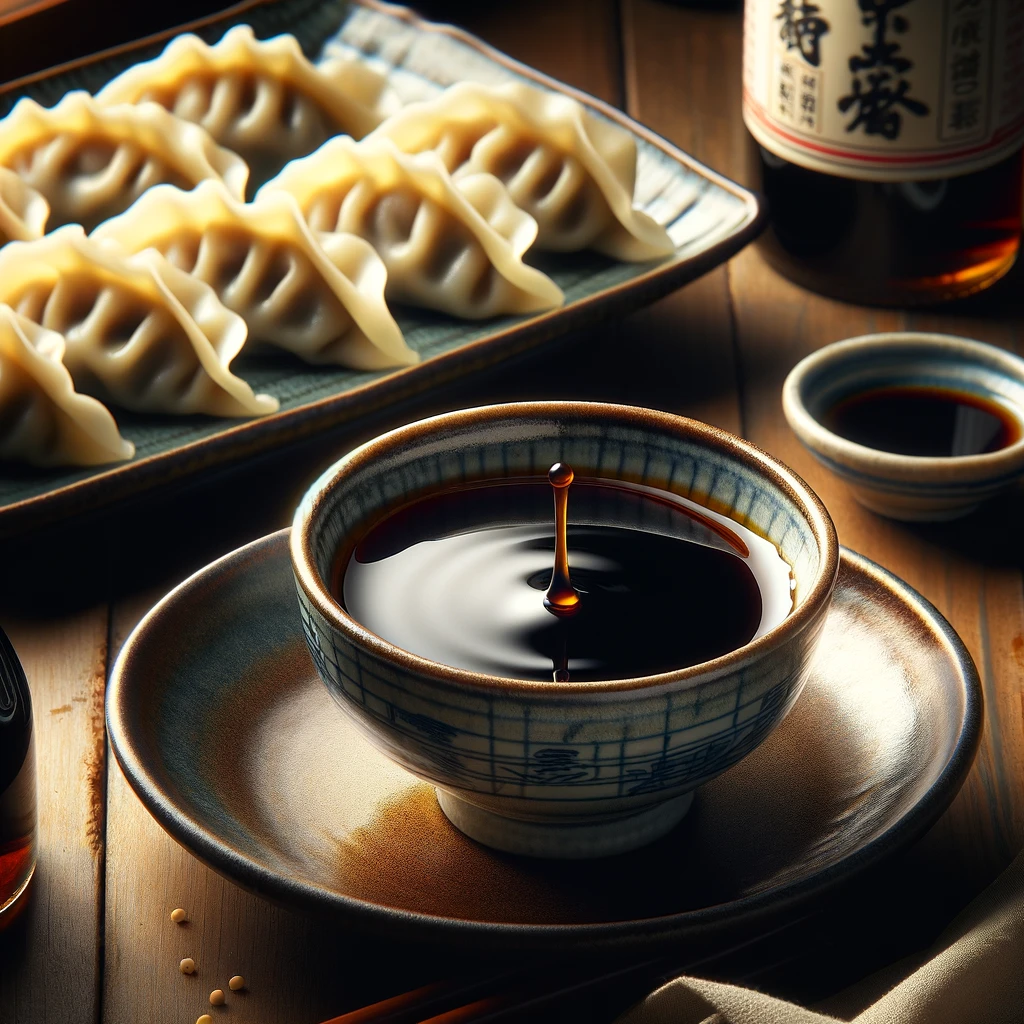
Ingredients:
- 1/4 cup soy sauce or tamari (for a gluten-free option)
- 2 tablespoons rice vinegar
- 1-2 teaspoons toasted sesame oil
- 1-2 teaspoons sugar (white or brown, adjust to taste)
- 1-2 cloves garlic, minced (optional)
- Red pepper flakes or sliced green chilies (optional, for heat)
- Chopped green onions or cilantro for garnish (optional)
Instructions:
- In a bowl, whisk together the soy sauce, rice vinegar, toasted sesame oil, and sugar until the sugar is dissolved.
- Add minced garlic and red pepper flakes or sliced chilies for extra flavor and heat, if desired.
- Taste the dipping sauce and adjust the sweetness or spiciness according to your preference by adding more sugar or chili flakes.
- Garnish with chopped green onions or cilantro for a fresh and vibrant touch.
- Serve this classic dipping sauce alongside your dumplings, spring rolls, or other appetizers.
b). Sweet Chili Rice Vinegar Dipping Sauce:
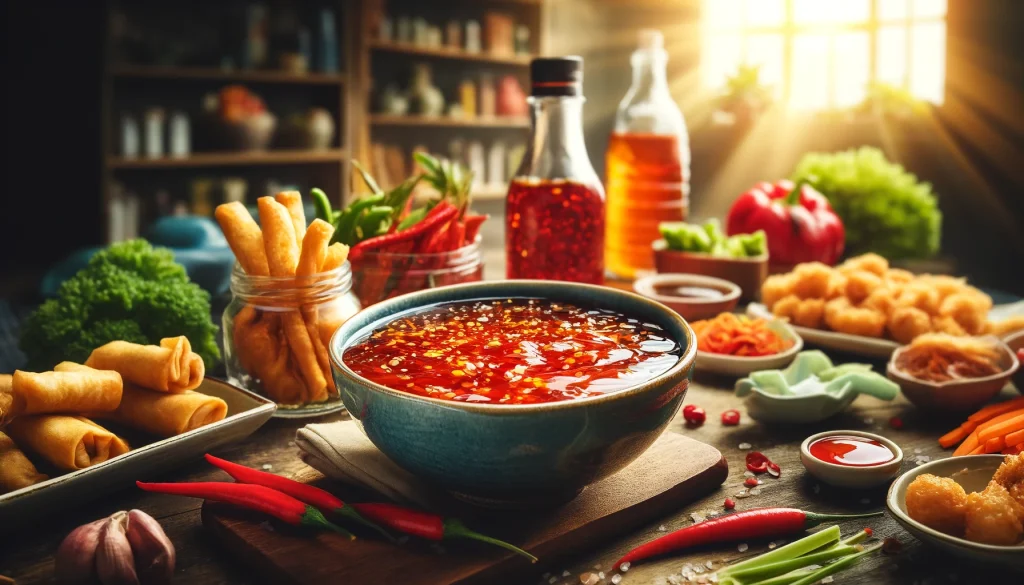
Ingredients:
- 1/4 cup rice vinegar
- 2 tablespoons sweet chili sauce
- 1-2 teaspoons soy sauce or tamari (for saltiness, adjust to taste)
- 1-2 teaspoons honey or brown sugar (adjust to taste)
- 1 clove garlic, minced
- Chopped cilantro for garnish (optional)
Instructions:
- In a bowl, combine the rice vinegar, sweet chili sauce, soy sauce, honey or brown sugar, and minced garlic.
- Taste the sauce and adjust the sweetness, saltiness, or spiciness by adding more honey, soy sauce, or sweet chili sauce.
- Garnish with chopped cilantro for a burst of freshness.
- This sweet and tangy dipping sauce is perfect for spring rolls and crispy appetizers.
c). Ginger-Sesame Rice Vinegar Dipping Sauce:

Ingredients:
- 1/4 cup rice vinegar
- 1-2 tablespoons soy sauce or tamari
- 1-2 teaspoons toasted sesame oil
- 1-2 teaspoons grated fresh ginger
- 1 clove garlic, minced
- 1-2 teaspoons honey or brown sugar (adjust to taste)
- Toasted sesame seeds for garnish (optional)
- Chopped green onions for garnish (optional)
Instructions:
- In a bowl, combine the rice vinegar, soy sauce, toasted sesame oil, grated fresh ginger, minced garlic, and honey or brown sugar.
- Taste the sauce and adjust the sweetness or saltiness by adding more honey or soy sauce.
- Garnish with toasted sesame seeds and chopped green onions for added texture and flavor.
- This dipping sauce pairs wonderfully with dumplings and other Asian-inspired appetizers.
Feel free to adjust the ingredient quantities to suit your taste preferences for sweetness, saltiness, and spiciness. Rice vinegar’s mild acidity makes it a versatile base for creating a variety of savory dipping sauces that can elevate the flavors of your favorite appetizers.
9. How to make ceviche and poke bowls by using rice vinegar to “cook” seafood
Ceviche and poke bowls are both delicious dishes that feature “cooked” seafood using the acid from citrus juice, typically lime or lemon juice. However, if you want to incorporate rice vinegar into your recipes, you can create a unique twist on these dishes by using rice vinegar to marinate the seafood instead of citrus juice. Here’s how to make rice vinegar-marinated ceviche and poke bowls:
a). Rice Vinegar-Marinated Ceviche:
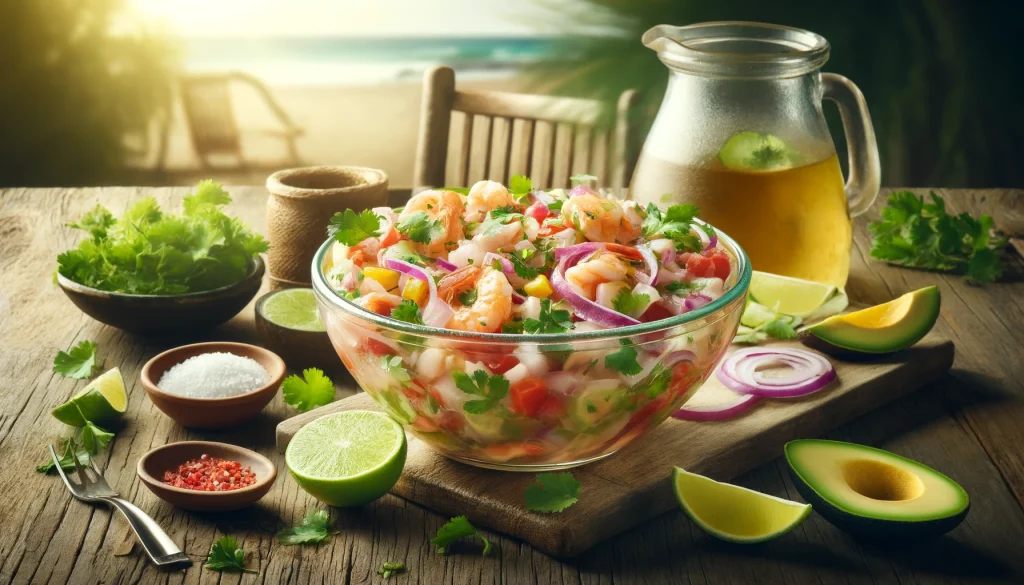
Ingredients:
For the ceviche:
- 1 lb fresh seafood (choose your favorite, such as white fish, shrimp, or scallops), diced into small pieces
- 1/2 cup rice vinegar
- 1/4 cup water
- 1-2 tablespoons sugar
- 1-2 teaspoons salt
- 1-2 cloves garlic, minced
- Red onion, thinly sliced (to taste)
- Fresh cilantro, chopped (to taste)
- Jalapeño or chili pepper, thinly sliced (optional, for heat)
- Avocado slices (optional, for garnish)
Instructions:
- In a bowl, combine the rice vinegar, water, sugar, salt, and minced garlic. Mix until the sugar and salt dissolve. Taste the mixture and adjust the sweetness or saltiness as needed.
- Place the diced seafood into the rice vinegar mixture, making sure the seafood is fully submerged. Cover the bowl and refrigerate for at least 30 minutes to marinate. You can also marinate it longer for a more intense flavor.
- While the seafood is marinating, soak the thinly sliced red onion in cold water for about 10 minutes to reduce its sharpness. Drain and set aside.
- When ready to serve, drain the marinated seafood, discarding the liquid.
- Toss the marinated seafood with the sliced red onion, chopped cilantro, and jalapeño slices (if using). Adjust the seasoning with more salt or sugar if needed.
- Serve the rice vinegar-marinated ceviche with avocado slices if desired.
b). Rice Vinegar-Marinated Poke Bowl:
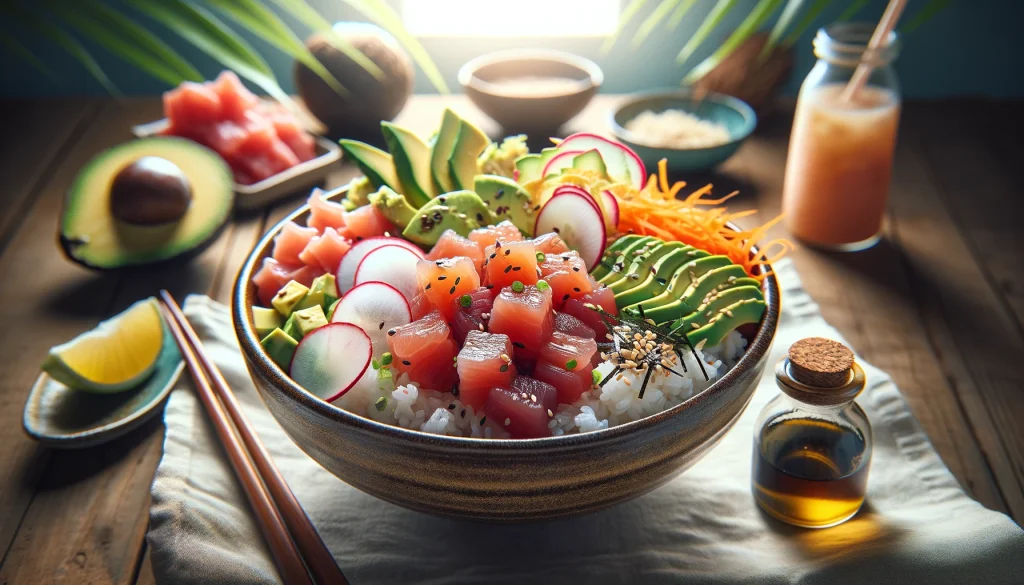
Ingredients:
For the poke:
- 1 lb fresh sushi-grade fish (such as ahi tuna or salmon), diced into bite-sized cubes
- 1/4 cup rice vinegar
- 2 tablespoons soy sauce or tamari
- 1-2 tablespoons sesame oil
- 1-2 teaspoons sugar
- 1-2 cloves garlic, minced
- Fresh ginger, grated (to taste)
- Green onions, thinly sliced (to taste)
- Sesame seeds (for garnish)
- Sliced cucumber, avocado, and seaweed salad (optional, for bowl components)
Instructions:
- In a bowl, combine the rice vinegar, soy sauce, sesame oil, sugar, minced garlic, and grated ginger. Taste the mixture and adjust the sweetness or saltiness to your liking.
- Place the diced sushi-grade fish into the rice vinegar mixture, ensuring that the fish is fully coated. Cover the bowl and refrigerate for at least 30 minutes to marinate.
- While the fish is marinating, prepare the optional components for your poke bowl, such as sliced cucumber, avocado, and seaweed salad.
- When ready to serve, remove the marinated fish from the refrigerator and drain it, discarding the liquid.
- Assemble your poke bowl by placing the marinated fish over a bed of rice (white or brown) and adding your choice of optional components.
- Garnish your poke bowl with sliced green onions and sesame seeds for added flavor and texture.
These rice vinegar-marinated ceviche and poke bowl recipes provide a unique twist on these classic dishes while still delivering the bright and refreshing flavors you expect from citrus-based versions. Enjoy your seafood with a delightful tanginess from the rice vinegar marinade.
10. Mixing rice vinegar into cocktail and mocktail recipes for a unique twist
Rice vinegar can add a unique and slightly tangy flavor to both cocktails and mocktails, creating a delightful twist on your favorite drinks. Here are a few cocktail and mocktail ideas that incorporate rice vinegar:
a). Rice Vinegar Margarita (Cocktail):

Ingredients:
- 2 oz tequila
- 1 oz triple sec or orange liqueur
- 1 oz rice vinegar
- 1 oz fresh lime juice
- 1/2 oz simple syrup (adjust to taste)
- Ice
- Lime wedge and salt (for rimming, optional)
Instructions:
- Rim the glass with salt, if desired. To do this, wet the rim with a lime wedge and dip it into a shallow plate of salt.
- In a shaker, combine the tequila, triple sec, rice vinegar, fresh lime juice, and simple syrup.
- Fill the shaker with ice and shake vigorously for about 15-20 seconds
- Strain the mixture into the prepared glass filled with ice.
- Garnish with a lime wedge.
b). Cucumber Rice Vinegar Cooler (Mocktail):

Ingredients:
- 1/2 cucumber, peeled and sliced
- 1 oz rice vinegar
- 1 oz honey or simple syrup
- 1 oz fresh lime juice
- Sparkling water or soda water
- Ice
- Cucumber slices and mint leaves for garnish
Instructions:
- Muddle the cucumber slices in a cocktail shaker or glass to release their juices.
- Add the rice vinegar, honey or simple syrup, and fresh lime juice to the muddled cucumber. Stir to combine.
- Fill the glass with ice and top it off with sparkling water or soda water.
- Stir gently to mix everything together.
- Garnish with cucumber slices and fresh mint leaves.
c). Berry Rice Vinegar Spritz (Mocktail):
Ingredients:
- 1/2 cup mixed berries (such as strawberries, blueberries, or raspberries)
- 1 oz rice vinegar
- 1 oz honey or simple syrup
- Sparkling water or soda water
- Ice
- Mixed berries and mint sprig for garnish
Instructions:
- In a glass, muddle the mixed berries to extract their flavors.
- Add the rice vinegar and honey or simple syrup to the muddled berries and stir well.
- Fill the glass with ice and top it off with sparkling water or soda water.
- Stir gently to combine the ingredients.
- Garnish with additional mixed berries and a sprig of fresh mint.
These rice vinegar-infused cocktails and mocktails offer a refreshing and tangy twist to your typical drink recipes. Feel free to adjust the sweetness and acidity levels to your taste preferences and experiment with different fruits and herbs for additional variations. Enjoy your unique and flavorful creations!
11. Surprising uses of rice vinegar in dessert recipes

Rice vinegar might not be a typical ingredient in dessert recipes, but it can add a unique and unexpected twist to your sweet treats. Here are some surprising uses of rice vinegar in dessert recipes:
a). Rice Vinegar-Infused Fruit Compote:
Create a flavorful fruit compote by adding a hint of rice vinegar. The mild acidity of the vinegar will enhance the natural sweetness of the fruits. Use this compote as a topping for ice cream, yogurt, or pound cake.
Ingredients:
- Assorted fruits (e.g., berries, peaches, apples)
- 1-2 tablespoons rice vinegar
- Sugar (to taste)
Instructions:
- Slice or chop the fruits into bite-sized pieces.
- In a saucepan, combine the fruits, rice vinegar, and sugar (adjust to taste)
- Cook over medium heat until the fruits soften and release their juices, about 10-15 minutes.
- Let the compote cool before serving it as a dessert topping.
b). Rice Vinegar Sorbet:
Create a tangy and refreshing sorbet with rice vinegar as the star ingredient. The vinegar will provide a unique contrast to the sweetness of the sorbet.
Ingredients:
- 1 cup water
- 1 cup sugar
- 1/2 cup rice vinegar
- 1-2 tablespoons lemon juice (optional, for added brightness)
Instructions:
- In a saucepan, combine water and sugar. Heat over medium heat, stirring until the sugar completely dissolves to create a simple syrup.
- Remove the syrup from heat and allow it to cool.
- Once the syrup is cool, mix in the rice vinegar and lemon juice.
- Pour the mixture into an ice cream maker and follow the manufacturer’s instructions for churning.
- Transfer the sorbet to a container and freeze until firm. Serve and enjoy the unique tanginess of rice vinegar sorbet.
c). Rice Vinegar-Infused Chocolate Ganache:
Enhance your chocolate desserts with a subtle tang by incorporating rice vinegar into your chocolate ganache. It works well with chocolate cakes, brownies, and tarts.
Ingredients:
- 1/2 cup heavy cream
- 1 tablespoon rice vinegar
- 6 oz semisweet chocolate, chopped
- 1 tablespoon unsalted butter (optional, for added richness)
Instructions:
- In a saucepan, heat the heavy cream and rice vinegar over medium heat until it just begins to simmer. Do not let it boil.
- Remove from heat and add the chopped chocolate. Stir until the chocolate is completely melted and the mixture is smooth.
- If desired, stir in butter for added richness.
- Let the ganache cool slightly before using it as a topping or filling for your desserts.
These surprising uses of rice vinegar in dessert recipes can add a unique and intriguing dimension to your sweet creations. The mild acidity of rice vinegar can balance the sweetness of desserts and create a more complex flavor profile.
12. Unconventional uses of rice vinegar in cleaning and household applications

Rice vinegar can be a versatile and eco-friendly cleaning agent with various unconventional uses in cleaning and household applications. Here are some surprising ways to use rice vinegar for cleaning and other household tasks:
1. Glass and Mirror Cleaner:
- Mix equal parts rice vinegar and water in a spray bottle.
- Use it to clean glass surfaces, mirrors, and windows for a streak-free shine.
2. Deodorize the Fridge:
- Place a small bowl of rice vinegar in your refrigerator to help neutralize odors.
3. Coffee Maker Descaler:
- Fill the coffee maker’s reservoir with a mixture of 1 part rice vinegar to 2 parts water.
- Run the coffee maker through a brewing cycle without coffee.
- Rinse thoroughly with water to remove any residual vinegar taste.
4. Microwave Cleaner:
- In a microwave-safe bowl, combine 1 cup of water and 1/4 cup of rice vinegar.
- Heat the mixture in the microwave until it boils and creates steam.
- The steam will help loosen dried-on food and stains. Wipe down the interior with a cloth.
5. Fabric Softener Substitute:
- Add 1/2 cup of rice vinegar to the rinse cycle when doing laundry as a natural fabric softener and to help remove detergent residue.
6. Pet Stain and Odor Remover:
- Blot up as much of the pet stain as possible.
- Mix equal parts water and rice vinegar and pour it over the stain.
- Blot the area with a clean cloth until the stain and odor are lifted.
7. Brass and Copper Cleaner:
- Make a paste with rice vinegar and salt.
- Apply the paste to brass or copper items, scrub gently, and rinse with water. It will help restore shine to tarnished metal.
8. Remove Water Stains on Furniture:
- Combine equal parts rice vinegar and olive oil.
- Dip a cloth into the mixture and rub it over water stains on wooden furniture.
9. Deter Fruit Flies:
- Place a small bowl of rice vinegar with a few drops of dish soap on your kitchen counter.
- The scent will attract fruit flies, and the soap will trap them.
10. Clean Sponges:
- Soak sponges in a mixture of equal parts water and rice vinegar to help disinfect and remove odors.
11. Weed Killer:
- Spray pure rice vinegar on weeds in your garden. The acidity can kill or inhibit their growth.
12. Carpet Stain Remover:
- Mix 2 tablespoons of salt and 1/2 cup of rice vinegar.
- Rub the mixture into carpet stains, let it sit for a few hours, and then vacuum it up.
When using rice vinegar for cleaning and household applications, remember to test it in an inconspicuous area first, especially on delicate surfaces. Also, ensure proper ventilation when using vinegar in enclosed spaces. Rice vinegar is an eco-friendly and cost-effective alternative to commercial cleaning products for various household tasks.
Proper Storage Methods for Rice Vinegar to Maintain Its Freshness and Flavor
Proper storage of rice vinegar is essential to maintain its freshness, flavor, and quality over time. Here are some guidelines on how to store rice vinegar effectively:
- Seal the Bottle Tightly: Always ensure that the bottle or container of rice vinegar is tightly sealed when not in use. This prevents air from entering the bottle, which can lead to the vinegar’s oxidation and deterioration.
- Keep it in a Cool, Dark Place: Store rice vinegar in a cool, dark location, away from direct sunlight and heat sources. A pantry or kitchen cabinet is an ideal choice. Exposure to light and heat can cause the vinegar to degrade and lose its flavor.
- Avoid Temperature Fluctuations: Try to maintain a stable temperature in the storage area. Extreme temperature fluctuations can affect the quality of the vinegar. Avoid storing it near stovetops, ovens, or radiators.
- Use an Airtight Container: If you transfer rice vinegar to a different container for convenience, make sure it’s an airtight container. Glass bottles with airtight caps or containers designed for storing vinegar are good options.
- Check for Leaks: Ensure that the bottle or container is not leaking, as moisture can introduce unwanted bacteria or contaminants. Wipe the bottle clean if there are any spills.
- Keep it Away from Strong Odors: Rice vinegar can absorb odors from its surroundings. Store it away from pungent or strong-smelling substances like onions, garlic, or spices.
- Check the Best-Before Date: Be aware of the expiration date or best-before date on the bottle. While rice vinegar has a long shelf life, using it before it expires ensures optimal flavor and quality.
- Refrigeration (Optional): While rice vinegar can be stored at room temperature, some people prefer to refrigerate it for longer shelf life. Refrigeration can help maintain its flavor for an extended period. If you choose to refrigerate it, make sure the container is sealed tightly to prevent the vinegar from absorbing other food odors in the fridge.
- Shake Before Use: Before using rice vinegar, give it a gentle shake or stir. This helps distribute any settled solids and ensures consistent flavor.
- Check for Spoilage: Occasionally check the rice vinegar for signs of spoilage, such as unusual odors, discoloration, or changes in texture. If you notice any of these, it’s best to discard the vinegar.
Rice vinegar, when stored properly, can maintain its freshness and flavor for an extended period. However, even if it has been stored for a while, rice vinegar can often still be used in cooking, as its acidity helps preserve it. When in doubt, rely on your senses: if it smells and tastes fine, it’s likely still good to use.
Tips on handling rice vinegar safely in the kitchen
Handling rice vinegar safely in the kitchen is important to prevent contamination and ensure food safety. Here are some tips on how to handle rice vinegar safely:
- Wash Hands: Always start by washing your hands thoroughly with soap and warm water before handling rice vinegar or any food items. Proper hand hygiene is essential in the kitchen.
- Use Clean Utensils: Ensure that all utensils, containers, and equipment used with rice vinegar are clean and free from any contaminants. Dirty utensils can introduce bacteria or impurities into the vinegar.
- Check for Contaminants: Before using rice vinegar, inspect it for any signs of contamination, such as unusual color, odor, or mold growth. If you notice any of these, discard the vinegar.
- Use a Clean Pouring Spout: If you transfer rice vinegar to another container, make sure the pouring spout or cap is clean and sanitized. This helps prevent cross-contamination.
- Store Properly: Store rice vinegar according to the manufacturer’s instructions and the guidelines mentioned in a previous response. Proper storage helps maintain its quality and safety.
- Avoid Double Dipping: When using rice vinegar for dipping sauces or dressings, avoid double-dipping used utensils or food items into the vinegar. Use separate utensils or pour a portion into a small dish for dipping.
- Prevent Cross-Contamination: Be cautious not to cross-contaminate other ingredients with rice vinegar. Avoid using the same utensils or cutting boards for raw meats and vegetables when handling vinegar.
- Label Containers: If you decant rice vinegar into different containers for convenience, label them clearly to avoid confusion with other liquids, such as water or apple cider vinegar.
- Refrigerate When Necessary: While rice vinegar can be stored at room temperature, some people prefer refrigerating it for prolonged freshness. If you choose to refrigerate, ensure the cap or lid is tightly sealed to prevent absorption of other odors from the fridge.
- Clean Up Spills Promptly: If you spill rice vinegar, clean it up immediately to prevent slipping hazards and to avoid attracting insects or pests.
- Use Within Expiry Date: Check the best-before date on the rice vinegar bottle and use it before it expires for optimal flavor and quality.
- Taste Safely: When tasting a dish that includes rice vinegar, use a clean utensil for sampling, not the same utensil that has been in contact with raw ingredients.
- Educate Yourself: Familiarize yourself with food safety guidelines and practices, including proper storage and handling of all ingredients in your kitchen.
By following these tips, you can handle rice vinegar safely in the kitchen and minimize the risk of contamination or foodborne illnesses while enjoying its unique flavor in your recipes.
Frequently Asked Questions (FAQ’s)
Here are some common questions and answers about how to use rice vinegar:
Q: What is rice vinegar, and how is it different from other types of vinegar?
A: Rice vinegar is a type of vinegar made from fermented rice wine. It has a mild, slightly sweet flavor compared to other vinegars like white or apple cider vinegar. There are different varieties of rice vinegar, including white rice vinegar, seasoned rice vinegar, and black rice vinegar, each with its unique flavor profile.
Q: Can I use rice vinegar as a substitute for other types of vinegar in recipes?
A: Yes, rice vinegar can be used as a substitute for other vinegars in many recipes. It’s a great choice for salad dressings, marinades, and Asian dishes. However, keep in mind that it has a milder flavor, so you may need to adjust the quantity to match the acidity of the original vinegar.
Q: How do I use rice vinegar in salad dressings?
A: To make a simple rice vinegar salad dressing, combine rice vinegar with oil (usually a neutral oil like vegetable or sesame oil), a touch of sugar or honey, salt, and any desired herbs or seasonings. Shake or whisk the ingredients together until well combined.
Q: What’s the best way to use rice vinegar in sushi rice?
A: To make sushi rice, you’ll typically mix rice vinegar, sugar, and salt and then fold this mixture into freshly cooked sushi rice. The vinegar mixture is key to achieving the characteristic sticky and slightly tangy sushi rice that’s used for making sushi rolls and nigiri.
Q: Can rice vinegar be used in marinades for meats and poultry?
A: Yes, rice vinegar can be used in marinades to add flavor and tenderize meats and poultry. It pairs well with soy sauce, ginger, garlic, and other seasonings to create delicious marinades for various dishes.
Q: How can I use rice vinegar to pickle vegetables?
A: Rice vinegar is a popular choice for pickling vegetables. To make a basic rice vinegar pickle, combine rice vinegar with sugar, salt, and water. Pour this mixture over sliced or chopped vegetables and let them marinate in the refrigerator for several hours or overnight.
Q: What are some unique dessert recipes that feature rice vinegar as an ingredient?
A: While not as common, rice vinegar can be used in desserts to add a subtle tanginess. You can try recipes like rice vinegar fruit compote, rice vinegar sorbet, or rice vinegar-infused chocolate ganache for a unique twist.
Q: Is rice vinegar gluten-free?
A: Generally, rice vinegar is considered gluten-free. However, it’s essential to check the product label, as some seasoned rice vinegars may contain additional ingredients that could introduce gluten.
Q: How do I store rice vinegar to maintain its freshness?
A: Store rice vinegar in a cool, dark place, away from direct sunlight and heat sources. Ensure that the bottle or container is tightly sealed to prevent air from entering, and avoid temperature fluctuations.
Q: Can I use rice vinegar for cleaning and household purposes?
A: Yes, rice vinegar can be used for cleaning and household applications. It can be an eco-friendly alternative for tasks like cleaning glass, deodorizing the fridge, and descaling appliances. However, be cautious when using it around certain surfaces, as it can be acidic and potentially damage sensitive materials.
Feel free to ask more specific questions about using rice vinegar, and I’ll be happy to provide detailed answers!
Conclusion
As we conclude our exploration of the diverse uses of rice vinegar, it’s clear that this tangy elixir is much more than a simple condiment. Its versatility extends far beyond the realm of Asian cuisine, as it finds its way into salad dressings, marinades, desserts, and even cleaning solutions. With its mild acidity and subtle sweetness, rice vinegar has the power to elevate the flavors of your dishes and simplify household tasks.
Whether you’re a culinary enthusiast looking to experiment with new flavors or someone seeking eco-friendly cleaning alternatives, rice vinegar is a valuable addition to your kitchen arsenal. Remember to store it properly, handle it safely, and let your creativity flourish as you explore the countless possibilities it offers.
So, the next time you reach for that bottle of rice vinegar, think beyond the salad bowl or sushi rice. Embrace the unexpected and add a tangy twist to your culinary creations and household routines. Rice vinegar is not just a condiment; it’s a versatile companion on your journey to delicious and efficient living.






